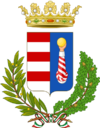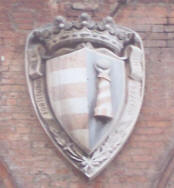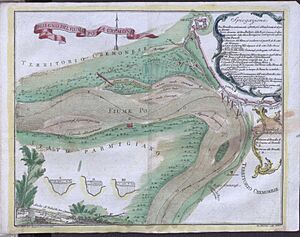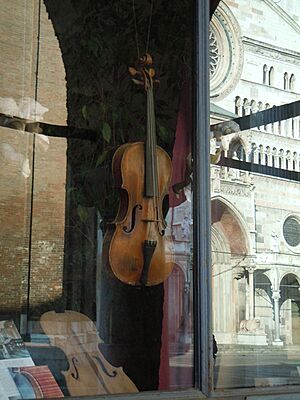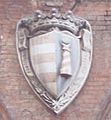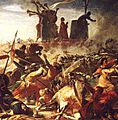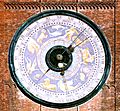Cremona facts for kids
Quick facts for kids
Cremona
Cremùna (Lombard)
|
|||
|---|---|---|---|
| Comune di Cremona | |||
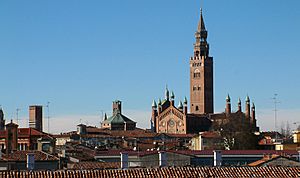
Panorama of Cremona
|
|||
|
|||
| Country | Italy | ||
| Region | Lombardy | ||
| Province | Cremona (CR) | ||
| Area | |||
| • Total | 69.7 km2 (26.9 sq mi) | ||
| Elevation | 47 m (154 ft) | ||
| Population
(1 January 2021)
|
|||
| • Total | 71,223 | ||
| • Density | 1,021.9/km2 (2,646.6/sq mi) | ||
| Demonym(s) | Cremonesi | ||
| Time zone | UTC+1 (CET) | ||
| • Summer (DST) | UTC+2 (CEST) | ||
| Postal code |
26100
|
||
| Dialing code | 0372 | ||
| Patron saint | St. Homobonus | ||
| Saint day | 13 November | ||
Cremona is a famous city in northern Italy. It is located in the Lombardy region, right by the Po River. Cremona is known around the world for its amazing musical history. It's especially famous for making string instruments like violins. Many of the first and best violin makers, called luthiers, came from here. These include Giuseppe Guarneri, Antonio Stradivari, and the Amati family.
Contents
History of Cremona
Cremona has a long and interesting history, going back thousands of years.
Ancient Times
Early Settlers
Cremona was first mentioned as a settlement of the Cenomani. This was a Gallic (Celtic) tribe. They arrived in the Po valley around 400 BC.
Roman Outpost
In 218 BC, the Romans built their first military outpost here. It was a colonia (a Roman settlement). They kept the old name, Cremona. This city, along with nearby Placentia (today's Piacenza), helped the Romans expand into northern Italy. Cremona grew quickly because it was on an important trade road. This road connected Genoa to Aquileia.
Cremona helped Julius Caesar and became very successful. But later, it supported his rivals. Because of this, in 40 BC, its land was taken and given to Roman soldiers. The famous poet Virgil went to school in Cremona. He lost his family farm, but later got it back.
City Rebuilt
Cremona continued to do well until 69 AD. It was then attacked and destroyed during a battle. This battle was part of a fight to decide who would be the next Roman Emperor. The new emperor, Vespasian, helped rebuild Cremona. However, it seems the city never became as rich as before. It disappeared from history for a while.
In the 6th century, Cremona became important again. It was a military base for the Eastern Roman (Byzantine) Empire. This was during the Gothic War.
Middle Ages
Lombard Rule
In 603 AD, the Lombard King Agilulf conquered Cremona. The city was destroyed again. But in 615 AD, Queen Theodelinda had Cremona rebuilt. She also brought a bishop back to the city.
Becoming a Free City
Control of Cremona slowly went to its bishop. The bishop became a vassal (a loyal supporter) of the Holy Roman Empire. This happened after Charlemagne conquered Italy. Cremona grew in power and wealth. Some of its bishops became very important. For example, Bishop Liutprand of Cremona was part of the Imperial court.
The city's economy also got a boost. A river port was built from an old Byzantine fort.
Medieval Commune
Cremona became a free city around 1093. It joined an alliance against the Empire. This alliance included Lodi, Milan, and Piacenza. Cremona won more land, including the area around Crema. After this, Cremona often fought with nearby cities to get more land.
Like many cities in northern Italy, Cremona had two main groups of people. The Guelphs were stronger in the "new city." The Ghibellines were based in the "old city." They disagreed so much that the Guelphs built a second city hall. It is still there today and is called Palazzo Cittanova.
Supporting the Emperor
When Frederick Barbarossa came to Italy, Cremona sided with him. They wanted his help against Crema and Milan. Cremona's loyalty earned it the right to make its own coins in 1154. In 1162, Cremonese and Imperial forces attacked and destroyed Milan.
Joining the Lombard League
However, in 1167, Cremona changed sides. It joined the Lombard League. Its soldiers helped defeat Barbarossa in the Battle of Legnano in 1176. But the Lombard League didn't last long. In 1213, Cremona defeated an alliance of other cities.
In 1232, Cremona allied with Emperor Frederick II. He was trying to control Northern Italy again. Cremona was on the winning side in the Battle of Cortenuova. Frederick often held his court in Cremona.
Later, Cremona defeated Parma's army. Its army captured Parma's carroccio (a special war wagon). For centuries, they kept the enemy's trousers hanging from the Cathedral's ceiling. This was a sign of their victory.
By 1301, Cremona was thriving. Its population grew to about 80,000 people. This was more than its population in 2001!
Rule by Lords
In 1266, the Ghibelline rule in Cremona ended. In 1271, a new position was created: Capitano del Popolo (People's Chieftain).
In 1276, the city came under the rule of the Cavalcabò family. They built or restored many important buildings. These included the bell tower of the Torrazzo and parts of the Cathedral. They also improved farming with new canals.
The Cavalcabò family ruled until 1322. Then, a more powerful family, the Visconti of Milan, took control. The Visconti family ruled Cremona for about 150 years. Cremona became part of the Duchy of Milan. It followed the Duchy's fate until Italy became one country. Under the Visconti and later the Sforza families, Cremona saw great cultural and religious growth.
In 1441, the city hosted the wedding of Francesco I Sforza and Bianca Maria Visconti. For this special event, a new sweet was created. This sweet later became the famous torrone.
Foreign Control
Venetian Rule
From 1499 to 1509, Cremona was controlled by Venice. After a battle, it returned to the Duchy of Milan.
Spanish Rule
Cremona was given to Spain in 1513. It became a Spanish territory in 1524. The French were finally kicked out of the duchy two years later. Cremona remained under Spanish rule for many years. During this time, several buildings were improved or added.
Spanish rule also brought hard times. Cremona suffered from a famine in 1628 and a terrible plague in 1630.
Austrian Rule
After a short time under French control in 1701, Cremona passed to Austria in 1707.
Famous Buildings and Places
Cremona has many beautiful and historic buildings.
Churches
- The Cathedral of Cremona and its Baptistery are very important. They show amazing Romanesque-Gothic art.
- Other churches include:
- Sant'Agata
- Sant'Agostino
- San Michele
- San Sigismondo
Other Buildings
- The Torrazzo is a huge bell tower. It is one of the tallest brick bell towers in Europe.
- Loggia dei Militi
- Palazzo Cittanova
- Palazzo Comunale (City Hall)
- Teatro Ponchielli (a theater)
- Museo del violino (Violin Museum)
Economy
Cremona's economy is closely linked to farming. The countryside around the city produces many agricultural products. Food industries are very important here. They make things like:
- Sweets, especially torrone (a type of nougat)
- Vegetable oils
- Cheeses like grana padano and provolone
- "Mostarda" (candied fruit in spicy mustard syrup)
There are also bigger industries like steel and oil. Cremona has a river port. This port is used for barges that carry goods along the Po River.
Music City
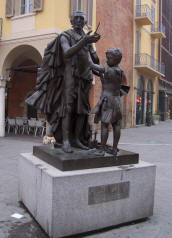
Cremona has a very special musical history. In the 12th century, the cathedral was a center for music. By the 16th century, Cremona was a famous music hub. Today, there are important groups for Renaissance and Baroque music. These groups and music festivals keep Cremona as a top music city in Italy.
Composer Claudio Monteverdi was born here. He is one of the most famous composers from the early Baroque period.
Starting in the 16th century, Cremona became known for making musical instruments. The violins made by the Amati and Rugeri families were famous. Later, the workshops of Guarneri and Stradivari became world-renowned. Even today, their handmade instruments are considered the best ever made.
Cremona is still known for making high-quality instruments. You can see rare examples at the local Museo del Violino (Violin Museum). In 2012, UNESCO declared "Traditional violin craftsmanship in Cremona" a special cultural heritage. This means the unique way Cremona's craftsmen make bowed string instruments by hand is very important to preserve. They do it without using any industrial materials.
Cremona also has a long tradition of band music. In 1864, Amilcare Ponchielli, who was from Cremona, became its leader. He created one of the greatest bands of all time. He also started a band school.
Transport
Cremona railway station, which opened in 1863, is a major transport hub. It is the end point for six railway lines. These lines offer regional or local services. You can travel from Cremona to cities like Pavia, Mantua, Milan, and Parma.
Sport
Football is Cremona's favorite sport. The U.S. Cremonese team played in Serie A (Italy's top league) for several years. Famous players like Antonio Cabrini and Gianluca Vialli were born near Cremona. In the early 1990s, Cremonese had a great time. They stayed in Serie A for three years. They also won the Anglo-Italian Cup in 1993. They defeated an English team at Wembley. This made them only the second Italian team to win there!
Cremona also has a strong basketball tradition. The Vanoli Basket team plays in Cremona. There is also a waterpolo club.
Rowing and canoe racing have a century-old tradition in Cremona. There are three clubs along the Po River. Many world and Olympic champions have trained there.
Sister Cities
Cremona is connected with other cities around the world. These are called sister cities:
 Alaquàs, Spain (since 2004)
Alaquàs, Spain (since 2004) Krasnoyarsk, Russia (since 2006)
Krasnoyarsk, Russia (since 2006) Füssen, Germany (since 2018)
Füssen, Germany (since 2018)
Notable People
Many famous people were born in or are connected to Cremona. Here are a few:
- Liutprand of Cremona (around 920 – 972), a bishop and historian.
- Gerard of Cremona (around 1114 – 1187), who translated many science books from Arabic to Latin.
- Andrea Amati (1505–1577), a very important violin maker.
- Sofonisba Anguissola (around 1532 – 1625), a famous painter.
- Claudio Monteverdi (1567–1643), a groundbreaking composer.
- Antonio Stradivari (around 1644–1737), perhaps the most famous violin maker ever.
- Giuseppe Guarneri (1698–1744), another legendary violin maker.
- Amilcare Ponchielli (1834–1886), a well-known composer.
- Ugo Tognazzi (1922–1990), a famous actor and director.
- Mina (born 1940), a popular singer known as the Tiger of Cremona.
- Antonio Cabrini (born 1957), a famous football player and manager.
- Gianluca Vialli (1964–2023), a celebrated football player and manager.
- Chiara Ferragni (born 1987), a well-known blogger and businesswoman.
Images for kids
-
The defence of the Carroccio during the battle of Legnano (1176) by Amos Cassioli (1832–1891)
-
Statue of Stradivari in Stradivari Square
See also
 In Spanish: Cremona para niños
In Spanish: Cremona para niños



